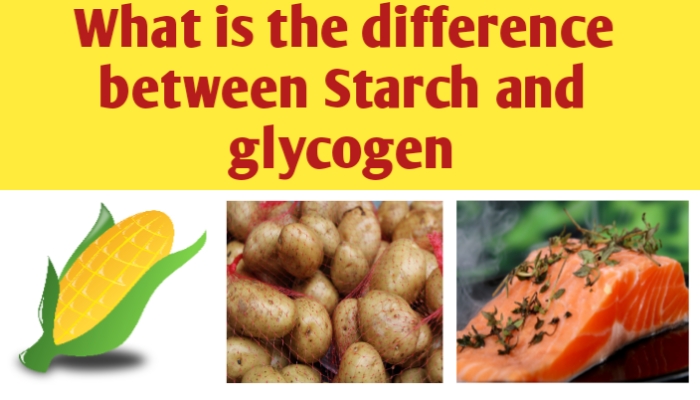What is the difference between Starch and Glycogen I Definition of Starch and Glycogen with examples l Starch vs Glycogen I how does Starch differ from Glycogen l how do you compare Starch and Glycogen l how do you distinguish Starch and Glycogen

What is the difference between Starch and Glycogen
As you know that the polysaccharides consist of more than six molecules of a monosaccharides and they are joined together by glycosidic bonds with a loss of water each time a monosaccharide molecule is added, the general formula for polysaccharide is (C6H10O5)n where n stands for the unknown number of monosaccharide molecules.
There are two important classes of polysaccharide- homopolysaccharides and heteropolysaccharides, examples of homopolysaccharides are Starch and Glycogen.
How do you compare between starch and glycogen? ,when you compare between starch and glycogen, starch is the reserve food material of plant cells, it is also called amylum, it is found in abundance in the seeds legumes and grains while glycogen is the main reserve food material of animal cells, it is also known as animal starch and it is stored in muscle cells and liver cells.
Hi guys in this article we know that about definition of starch and glycogen with examples and compare / differences / distinguish between starch and glycogen / Starch vs Glycogen
How do you distinguish Starch from Glycogen?, there are three main difference that you can distinguish Starch from Glycogen, 1) Starch is the main reserve food materials of plant cells while glycogen is the main reserve food materials of animal cells,
2) starch amylose molecule is unbranched while glycogen molecules is much branched and 3) Starch amylose molecule has 200-2000 glucose units while glycogen molecules has about 30,000 glucose units.
How does Starch differ from Glycogen?, 1) starch gives red colour with iodine while glycogen gives blue colour with iodine, 2) starch is stored in seeds, grains, tubers and fruits while glycogen grains are stored in the cytoplasm and usually associated with smooth endoplasmic reticulum, and 3) starch grains from a particular source have a characteristics form and structure while Glycogen grains have almost uniform shape and structure.
Definition and examples of Starch
Definition of starch:- Starch is define as the reserve food materials of plant cells, it is formed as an end product of photosynthesis and animals get it from the plants. Starch molecules accumulate to form starch grains, starch grain are of two kinds : simple and compound, example of starch are legumes, rice, wheat and maize .
Definition and examples of Glycogen
Definition of Glycogen :- Glycogen is define as the main reserve food materials of animal cells, it is animal starch, its molecules contain 30000 glucose units, successive glucose units are joined together by 1-4 alpha glycosidic bonds and branches are formed by 1-6 glycosidic bonds. Examples of glycogen found in muscle cells and liver cells.
What is the difference between starch and glycogen
This question is very important for class 8th,9th,10th,11th and 12th students who are preparing for competitive and annual board examination.
Regarding this ,” what is the difference between starch and glycogen?” the main difference between starch and glycogen are – 1)Starch consist of two components amylose and amylopectin both glucose polymers while glycogen forms groups of tiny ellipsoidal, flattened granules in the cells associated with smooth endoplasmic reticulum, 2) starch is the reserve food materials of plant cells while Glycogen is the main reserve food materials of animal cells and 3) starch gives blue colour with iodine while Glycogen gives red colour with iodine.
You can also click on the given link to see others topic in our website and YouTube channels
◆ ALSO READ: HEART ANATOMY, PHYSIOLOGY, LOCATION, DISEASE & TREATMENT
Starch vs glycogen/ List the 5 main difference between starch and glycogen/ Differentiate between starch and glycogen are as follows:-
Starch :-
1. Starch is the main storage carbohydrate source found in plants.
2. It is occurs in grains like rice, wheat, maize ,sorghum etc
3. Starch is made of monomer alpha glucose.
4. Amylose is an unbranched ,coiled chain and amylopectin is a long branched chain of which are some coiled.
5. Amylose is having 1,4 glycosidic bonds and amylopectin is having 1,6 glycosidic bonds
6. Starch is a white, granular, organic chemicals that is produced by all green plants.
7. Starch gives blue colour with iodine solution test.
8. Starch grains are stored in plastids chloroplast and amyloplasts.
9. Starch grain from a particular source have a characteristics form and structure.
10. A starch grain consist of several layers, the shell arranged in concentric manner around a point the hilum.
Glycogen:-
1. Glycogen is the main reserve food materials of animal cells.
2. It is stored in liver and muscles cells.
3. It is made of long branched chain of about 30000 glucose units.
4. Glycogen has a short many branched chains of glucose molecules where some chains are branched.
5. 1,4 and 1,6 glycosidic bonds occurs between the monomers.
6. Glycogen is white, amorphous tasteless polysaccharide, it is the principal form in which carbohydrate is stored in the higher animal.
7. glycogen gives red colour with iodine solution test.
8. Glycogen grains are stored in the cytoplasm, associated with smooth endoplasmic reticulum.
9. Glycogen grains have almost uniform shape band structure.
10. Glycogen readily breaks down into glucose units by hydrolysis when needed, glucose formed in the liver cells is delivered by the blood to the tissue for use in respiration.
Conclusions:-
Starch and glycogen serve as a source of energy, they are hydrolyzed to their constituents glucose monomer units by specific enzymes action.






Leave a Comment